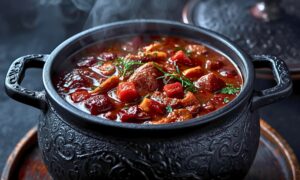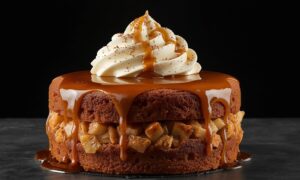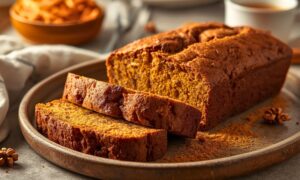A Salad That Doesn’t Play by the Old Rules
Let’s break one thing right out of the gate: this is not your grandma’s pasta salad. No mayo. No limp noodles. No soggy vegetables drowning in some vague “Italian” dressing. This is a new kind of comfort food, fresh, vivid, and built for the way we actually eat now. Lemon Basil Parmesan Pasta Salad takes everything you thought a cold pasta dish could be and completely rewrites the script.
You know that moment when you’re craving something refreshing, but you want more than just leaves on a plate? Something that tastes like summer without trying too hard? I landed there on a weekday afternoon with zero motivation and a kitchen that offered… well, let’s say “creative limitations.” But one lemon, a handful of basil, and the last of the parmesan sparked an idea, and it turned into a dish I’ve now made a dozen times.
The olive oil hit the pan with a hiss. The lemon zest lifted into the air like sunshine. Parmesan curled into silky ribbons over warm rotini, while torn basil released that unmistakable aroma, peppery, sweet, green. I wasn’t following a recipe. I was chasing flavor.
The result? Clean, citrusy brightness balanced with salty depth and just enough richness to feel like a treat. Every bite is balanced, bold, and meant to be shared, though you won’t want to.
In this post, I’ll show you how to recreate it from scratch, with tips for perfect texture, quick upgrades, and variations that work for every table. If you’re ready to retire tired side dishes, this is your new go to.
Why This Lemon Basil Parmesan Pasta Salad Changes Everything
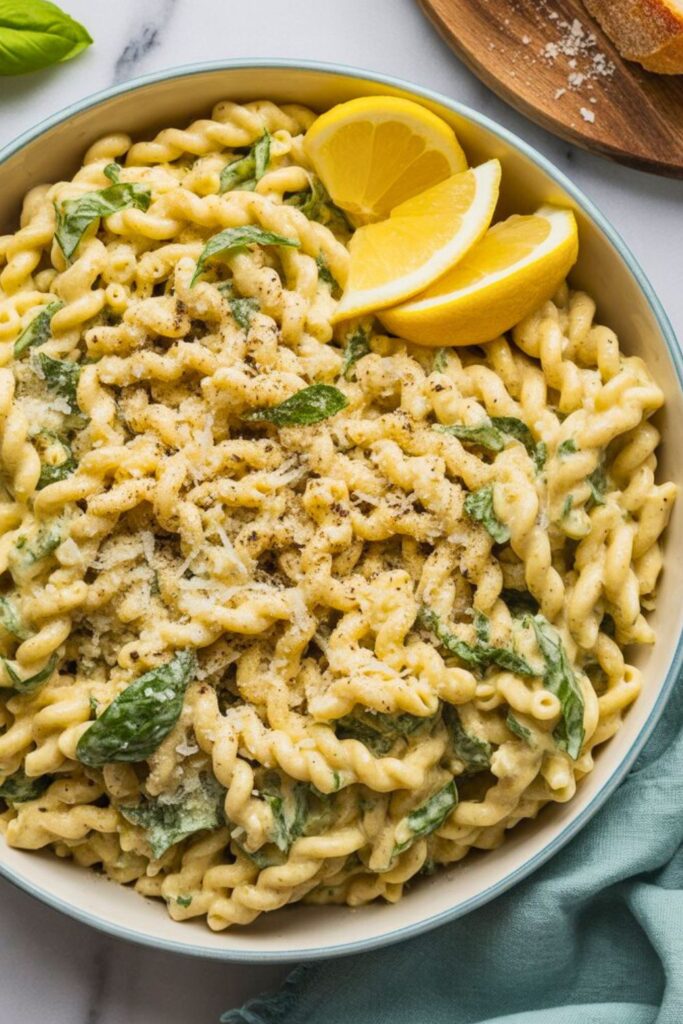
Most people cook pasta salad backwards. They boil everything, let it go stone cold, then wonder why it tastes flat and boring. We flip that script entirely.
The magic happens in those first few minutes after you drain the pasta. That residual heat becomes your best friend, helping flavors meld and ingredients transform. The Parmesan softens slightly. The lemon zest releases its oils. Everything melds together instead of sitting in separate, distinct layers.
This technique creates what I call “flavor bridges” connections between ingredients that make each bite taste more complex than the sum of its parts. You taste lemon, but it’s supported by herbs. You get the richness of cheese, but it’s brightened by citrus.
Getting Your Lemon Basil Parmesan Pasta Salad Ingredients Right
The Pasta Foundation That Actually Works
Choose shapes that grab onto dressing and trap flavor bits. Rotini works like magic here, those spirals catch herbs and cheese in every twist. Penne’s excellent too. Avoid smooth shapes like regular spaghetti that let everything slide off.
Cook it just shy of al dente. Sounds wrong, but trust the process. This pasta continues absorbing flavors as it sits. Perfect texture now means overcooked mush later.
Salt that pasta water aggressively. It should taste like mild seawater. This is your only chance to season the pasta itself from within.
The Parmesan Game Changer
Real Parmigiano Reggiano makes a difference you’ll taste immediately. But here’s the insider secret, don’t grate it too fine. You want pieces with substance that create little flavor explosions.
If budget’s tight, good aged Parmesan from your regular grocery store works fine. Just skip the pre grated stuff, those anti caking agents mess with the texture we’re building.
Grate it fresh right before using. Pre grated cheese loses those volatile flavor compounds that make this Lemon Basil Parmesan Pasta Salad sing.
Basil That Actually Delivers Flavor
Fresh basil is absolutely non negotiable here. Look for bright green leaves with no dark spots or wilting edges. The best basil smells incredible before you even touch it.
Here’s a technique most home cooks don’t know: tear basil by hand instead of chopping it. Knives bruise the leaves and release bitter compounds. Tearing preserves those bright, sweet flavors.
Buy basil the day you plan to use it if possible. It loses flavor quickly once picked.
The Lemon Situation Explained
You need both zest and juice, but they serve completely different purposes. Zest carries oils that provide bright, floral citrus flavor. Juice adds acidity that balances richness and keeps everything tasting fresh.
Use a microplane for zesting if you have one. Box grater holes grab too much bitter white pith. Be gentle and only get the yellow part.
Room temperature lemons yield more juice than cold ones. Roll them on the counter with pressure before cutting.
Step by Step Lemon Basil Parmesan Pasta Salad Magic
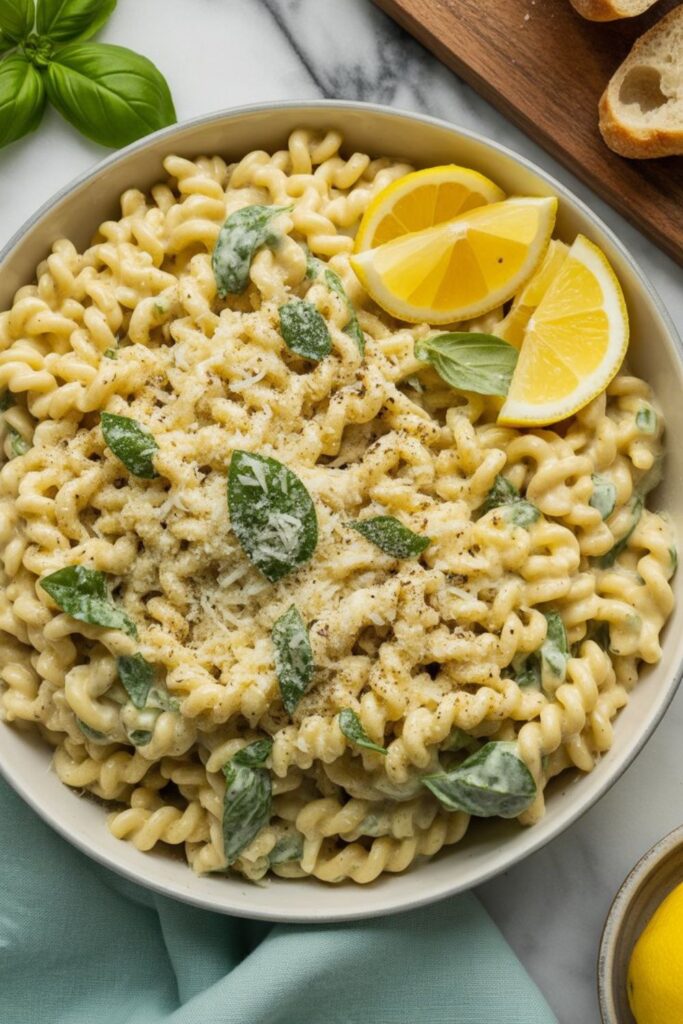
Getting the Pasta Perfect Every Time
Bring a large pot of water to a rolling boil. Pasta needs room to move or it sticks together in gummy clumps. Use more water than you think you need.
Drop pasta in and stir immediately. Stir again after two minutes. This prevents sticking without needing oil, which would prevent our dressing from adhering properly.
Start testing doneness two minutes before package directions suggest. You want just the tiniest bit of firmness left in the center.
The Critical Temperature Dance
Work quickly but don’t panic. Have everything prepped before you drain that pasta. This timing makes or breaks your Lemon Basil Parmesan Pasta Salad.
Toss warm pasta with half your Parmesan immediately. Watch it soften and start coating the noodles. This creates the creamy base that holds everything together.
Add lemon zest while there’s still residual heat. The warmth releases those essential oils and distributes them evenly throughout.
Building Perfect Flavor Layers
Add lemon juice next, just enough to brighten without overwhelming. Start with half what you think you need. You can always add more.
Drizzle in good olive oil. This isn’t just a vehicle, it’s a major flavor component. Use extra virgin with character, but nothing so strong it dominates.
Season with salt and pepper while everything’s still slightly warm. Heat helps seasonings penetrate rather than just sitting on the surface.
The Final Flavor Touch
Add basil last, after everything cools to just warm. Toss gently, don’t stir the life out of those delicate leaves.
Sprinkle remaining Parmesan now. These pieces stay distinct, creating little flavor surprises throughout your Lemon Basil Parmesan Pasta Salad.
Taste and adjust. More lemon? Another pinch of salt? Trust your palate.
The Science Behind Perfect Pasta Salad
Understanding the science makes you a better cook. When you add cheese to warm pasta, proteins soften and release moisture. That moisture carries flavor compounds that pasta absorbs, creating deeper taste.
Lemon zest contains limonenes, oils that give citrus its bright flavor. Heat releases more oils, but too much heat destroys them. Timing is everything.
Basil’s flavor comes from volatile terpenes, particularly linalool. These compounds disappear quickly when exposed to heat or air. Tearing minimizes cell damage. Adding basil last preserves maximum flavor.
Pasta acts like a flavor sponge. Those nooks in rotini don’t just hold dressing, they create microclimates where flavors concentrate and develop.
Making Your Lemon Basil Parmesan Pasta Salad Beautiful
Presentation affects taste more than you realize. We eat with our eyes first, so make it gorgeous.
Serve in a wide, shallow bowl rather than deep. This shows off colorful ingredients and makes serving easier. White bowls make green basil and golden cheese pop visually.
Right before serving, add fresh lemon zest and torn basil leaves on top. This creates immediate aroma when people lean in to serve themselves.
Perfect Pairings for Maximum Impact
This pasta salad complements grilled chicken or fish beautifully. The citrus cuts richness while cheese adds substance that supports protein perfectly.
Try it alongside grilled vegetables, especially zucchini, bell peppers, and tomatoes. The flavors echo and amplify each other.
For wine, choose crisp and bright. Pinot Grigio or Sauvignon Blanc echoes the lemon without competing. Light reds like Chianti work too.
Why This Lemon Basil Parmesan Pasta Salad Deserves Your Attention
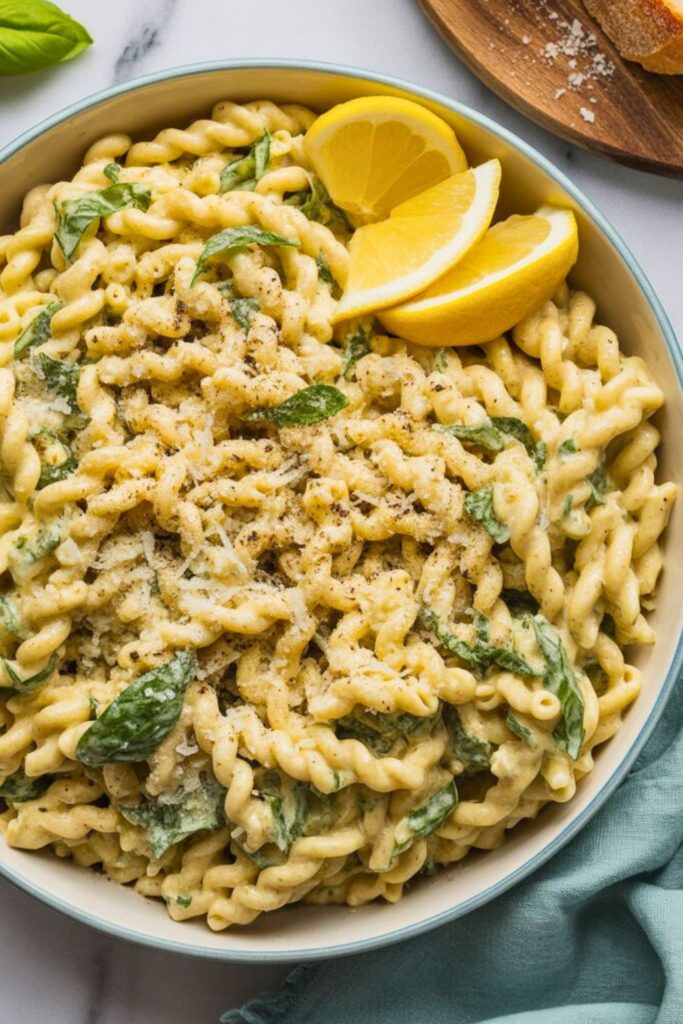
This recipe delivers restaurant quality results with weeknight ease. The technique sounds fussy, but becomes second nature after a couple attempts.
The real beauty lies in how it improves with time. Unlike mayo based salads that get soggy, this develops more complex flavors as it sits. Make it morning for dinner, or night before a party.
Store leftovers covered in the fridge for three days. Before serving again, let it reach room temperature for twenty minutes and toss gently. Add fresh lemon juice to brighten.
Remember: cooking isn’t about following rules blindly. Understand why rules exist so you can bend them intelligently. Master this foundation, then experiment with different herbs, cheeses, or citrus.
Frequently Asked Questions About Lemon Basil Parmesan Pasta Salad
Can I make this pasta salad ahead of time?
Absolutely, it’s actually better when you do. Make it up to twenty four hours ahead, but hold back half the basil and add it fresh before serving. Flavors develop beautifully overnight while avoiding wilted herbs. Let it reach room temperature before serving for best flavor.
What if I can’t find fresh basil?
Fresh basil makes this Lemon Basil Parmesan Pasta Salad shine, but if you’re stuck, try fresh spinach or arugula for different but delicious results. Fresh parsley with tiny bit of dried oregano works too. Skip dried basil entirely, it tastes dusty and lacks bright flavor.
How do I prevent mushy pasta?
The key is undercooking slightly and controlling temperature strategically. Cook pasta until just shy of al dente, then use residual heat purposefully. Don’t overdress, too much liquid makes pasta soggy over time. Start with less dressing than you think necessary.
Can I substitute the Parmesan with something else?
Sure, but choose wisely. Aged Asiago or Pecorino Romano work beautifully with similar texture but different flavors. For dairy free versions, try nutritional yeast with toasted pine nuts for richness. Avoid soft cheeses, they make everything gluey.
Why does my pasta salad taste bland?
Two common culprits: undersalting and serving too cold. Pasta needs aggressive seasoning because it’s mostly starch. Salt the cooking water properly, season each layer, and taste before serving. Let cold pasta salad warm slightly, extreme cold mutes all flavors.

Swiftly Captions by Tina Smith — Quick, flavorful food recipes made simple, bringing fresh inspiration to your kitchen every day


